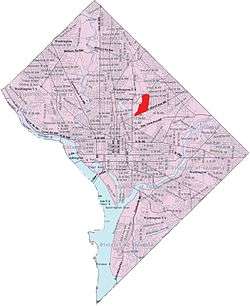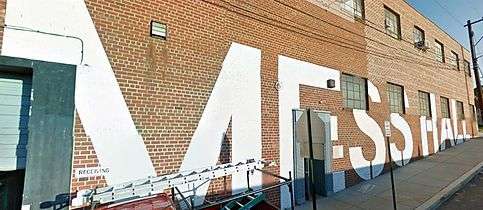Edgewood (Washington, D.C.)
| Edgewood | |
|---|---|
| Neighborhood of Washington, D.C. | |
|
Edgewood St NE | |
 Edgewood within the District of Columbia | |
| Coordinates: 38°55′21″N 77°00′02″W / 38.9226°N 77.0005°WCoordinates: 38°55′21″N 77°00′02″W / 38.9226°N 77.0005°W | |
| Country | United States |
| District | Washington, D.C. |
| Ward | Ward 5 |
| Government | |
| • Councilmember | Kenyan McDuffie |
| Website |
www |
Edgewood is a neighborhood in Northeast Washington, D.C., USA. Edgewood is bounded by Lincoln Road and Glenwood Cemetery to the west; the tracks for the Red Line of the Washington Metro to the east; Rhode Island Avenue NE to the south; and the combination of Irving Street, Michigan Avenue, and Monroe Street to the north. Edgewood is in Ward 5.
History
The neighborhood, outside the original boundaries of Washington City, was originally part a 30-acre (120,000 m2) farmland estate called Metropolis View, part of Washington County. In 1863, Salmon P. Chase, then U.S. Treasury Secretary under Abraham Lincoln, purchased the estate and attenuated another 20 acres (81,000 m2) of land nearby, built a mansion, and renamed the newly expanded estate Edgewood. The mansion itself was at what is now the corner of Edgewood and Fourth Streets NE. When Chase died in 1873, his daughter, Kate Chase Sprague, moved onto the crumbling estate and lived a reclusive life with her intellectually disabled daughter, farming pigs until she died in poverty in 1899.
In the 20th century, the house belonged to the St. Vincent's Orphanage Asylum and Catholic School, the largest orphanage for girls and a coed school. The city, however, gained possession of the remainder of the estate and around 1950 began developing it as an urban neighborhood.
Businesses and landmarks
- Monroe Street Market includes a number of businesses and restaurants such as Halsa, Busboys and Poets, Brookland Pint, Barnes & Noble, Chipotle, &pizza, Potbelly, Wardman Wines, plus artist residences and studios.[1]
- Dance Place
- Mess Hall[2]
- The Dew Drop Inn[3]
- Annie's Ace Hardware
- Edgewood Terrace, a large complex of mixed-income and senior-citizen public housing, opened in 1972.[4] It was built by Bethesda developer Eugene Ford, and it was originally managed by H.R. Crawford. Today, Edgewood Terrace remains a central landmark of the Edgewood neighborhood, enough so that the neighborhood itself is sometimes called Edgewood Terrace.
- The Metropolitan Branch Trail serves Edgewood.
- Edgewood Wall is part of Open Walls DC, a public art initiative that provides spaces and walls for graffiti artists, street artists, muralists, art students, emerging and established artists who love to paint outdoors and large.[5][5] The goal of Open Walls DC is to create large ever-changing murals that beautify our city and are unusual creative public spaces.
- Trinity Washington University
- Glenwood Cemetery
- St Mary's Catholic Cemetery
- United States Conference of Catholic Bishops
- National Federation for Catholic Youth Ministry
- Missionary Oblates of Mary Immaculate
- Washington Theological Consort
- Rhode Island Avenue Shopping Center
- Carmelite Friars Discalced
Gallery
 Mess Hall
Mess Hall Edgewood Wall
Edgewood Wall Sunflowers on Douglass St NE in Edgewood
Sunflowers on Douglass St NE in Edgewood Fall foliage in Edgewood
Fall foliage in Edgewood Edgewood Wall
Edgewood Wall
References
- ↑ "Luxury Apartments Washington, DC - Monroe Street Market".
- ↑ "Mess Hall".
- ↑ "Home - The Dew Drop Inn".
- ↑ "Edgewood Terrace Open in Northeast". The Washington Post. October 21, 1972. p. D2.
- 1 2 "ALBUS CAVUS OPEN WALLS".
External links
| Wikimedia Commons has media related to Edgewood, Washington, D.C.. |
- The Edgewood Map
- Washington Post: "Edgewood remains affordable but is becoming newly desirable"
- Washingtonian: "Strip Malls are Vanishing from Northeast DC. What’s Going to Take their Place?"
- UrbanTurf: "Edgewood: More Substance Than Style"
 |
Washington Hospital Center Veterans Affairs Medical Center |
Trinity Washington University | Stronghold |  |
| McMillan Reservoir | |
Brookland | ||
| ||||
| | ||||
| Bloomingdale | Eckington | Brentwood |
